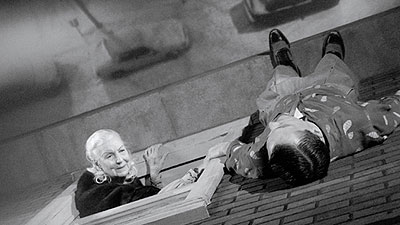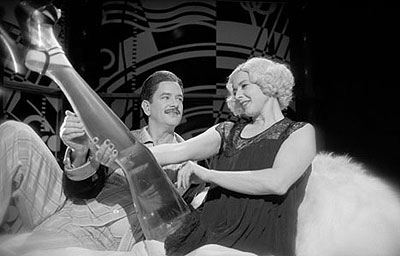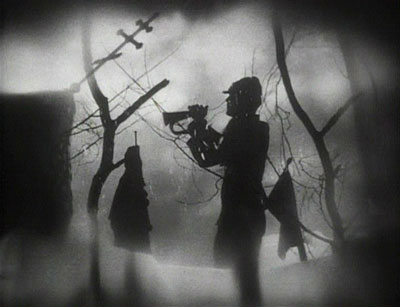A Crash Course in Maddinalia
Published on May 30th, 2012 in: Canadian Content, Issues, Movies, True Patriot Love |By Chelsea Spear
Guy Maddin carries on the tradition of deeply idiosyncratic experimental Canadian film from such forebears as David Cronenberg, Ryan Larkin, and Patricia Rozema. His work blends a voluptuous silent film aesthetic with fractured memories, mild body horror, and autobiographical details. His films contain gorgeous images, and the deliberate pacing draws in and engages viewers.
Maddin’s prolific filmmaking schedule serves as both a sop to his diehard fans, and an intimidation to those potentially interested in his work. When contemplating an IMDB profile that features over forty films, where do you start? A crash course in Maddin’s bizarre and wonderful oeuvre is in order.
GMDN 101: Short films
Maddin is perhaps best known for his short films, and many cineastes find his short subjects a good place to start their study in Maddinalia. His best known work, “The Heart of the World,” was distributed as a short before several features, including Downtown 81—where I first saw the film.
The short unfolds like a trailer for quite possibly the most incredible post-Eisensteinian Montage feature, replete with a Passion Play, a dildo that shoots money, and a chilly, charismatic female protagonist that could give False Maria from Metropolis a run for her money. The first time I saw “Heart of the World,” my jaw dropped into my lap—I couldn’t believe how beautifully Maddin had interwoven experimental film techniques (like the stroboscopic editing) and silent movie tropes into such a perfect film.
Prior to “Heart of the World,” Maddin helmed another well-distributed short: “Odilon Redon or the Eye Like a Strange Balloon Mounts Towards Infinity.”
This one has less of a straightforward narrative than “Heart of the World,” and instead draws from the visual art of Odilon Redon to create an impressionistic mood. A father and son vie for the affections of a woman who survives a train derailment . . . but will she remain loyal to the railroading family?
While the slip of a plot foreshadows the similarly quasi-incestuous love triangles of Maddin’s later feature-length films The Saddest Music in the World and Cowards Bend the Knee, the visuals share the simple yet breathtaking qualities that make Maddin’s work so ingratiating. The smudgy, contrast-heavy cinematography pays perfect tribute to Redon’s charcoal-based drawings, and the film’s hypnotic pacing draws the audience in and complements the striking visuals.
In more recent years, Maddin has collaborated with both Canadian organizations and high-profile individuals. While his more idiosyncratic work with legendary actress Isabella Rossellini has both attracted new fans and confused others, their short “My Dad Is 100 Years Old” provides another accessible point of entry into his formidable filmography.
All the things you love about Guy Maddin are here: the flashy editing, conflicts with the father, gender-bending, and tributes to early cinema. Rossellini—who acted in The Saddest Music and narrated Brand Upon the Brain!—provides voiceover narration to a series of memories of her father, the groundbreaking director Roberto Rossellini. Her recollections of her father’s life are punctuated by a series of short scenes in which she plays nearly every role, including those of Fellini, David O. Selznick, and her own mother, Ingrid Bergman. The palpable emotion and lush production values reflect, to some extent, the direction in which Maddin’s career has recently gone.
GMDN 200: Guy Maddin and Work For Hire
Maddin’s renown in his home country has led to some interesting opportunities to work with some of the notable talent north of the 49th Parallel. While most directors—particularly those as “out there” as Maddin—would sand off their quirks to make their work more palatable, Maddin’s journeyman work is as unusual as the things he’s made for himself.
One of Maddin’s most well-regarded features is Dracula: Pages from a Virgin’s Diary, made with the Royal Winnipeg Ballet. This is no mere filmed ballet. Maddin re-imagines the RWB’s production of Dracula as a silent horror film, and uses unusual camera angles, amusing inserts, and a variety of film stocks to make a feature closer to the early days of Universal Horror than to any of the Nutcracker adaptations that squeak into theaters at Christmastime.
While the ballet and Maddin’s film hew closely to Bram Stoker’s novel, he draws out some surprising themes from the novel and the ballet. His Dracula vibrates with a carnality not found in enough contemporary vampire movies—Tara Birtwhistle’s portrayal of Lucy has a frank sensuality that contrasts with the “sparkle-pires” of today’s Cineplex. The casting of Chinese dancer Zhang Wei-Qiang gives the film an additional layer of social commentary. The frequent description of Dracula as “the other” has never been quite as creepy. (The film was released at the height of the SARS scare, which made the discussion of blood-borne vampirism and the anti-Asian bigotry of the time even more frightening.)

My Winnipeg, 2007
In 2008, the Documentary Channel invited Maddin to make a feature film about Winnipeg, his lifelong hometown and the setting of several of his films. The feature that came of this pairing, My Winnipeg¸ depicted a town that Maddin (or at least a character named “Guy Maddin”) was itching to leave. The film portrays many of the highlights of Winnipeg history, such as the rise and fall of Maddin’s beloved Winnipeg Jets, and “If Day,” a staged Nazi invasion of Winnipeg and ill-fated war bonds fundraiser. It’s also one of the few films to compare Manitoba’s freezing winters to painful bare-back sex. Additionally, My Winnipeg has gained some notoriety as the final film in which legendary film noir leading lady Ann Savage appears. Savage, the formidable star of Edward G. Ulmer’s Detour, took her bow in the role of Guy’s elderly mother, a fearsome femme fatale in late middle age.
GMDN 300: Guy Maddin’s Feature-Length Works
By now you’ve viewed Maddin’s short films and his more straightforward collaborative works, so a closer look at his feature films is in order. Maddin scholars are of two minds regarding this approach. Some recommend The Saddest Music in the World (2003) as a fine starting point for his longer works. The plot unfolds like a screwball comedy on LSD and cough syrup: “a contest to determine which country’s music truly deserves to be called the saddest in the world” (per the film’s protagonist) unfolds in Depression-era Winnipeg. Amidst the drama, the music, and the bathing in kegs of beer, a pair of love stories unfold: a painful romance between lovelorn Serbian cellist Gavrillo (Ross McMillan) and his amnesiac ex-wife Narcissa (Maria de Medeiros), and a love triangle in which a father and son woo the legless beer baroness Lady Port-Huntley (Rossellini). The film’s bigger budget allows Maddin to deepen his art-deco aesthetic—check out the Lady P’s office and her beer legs—but his fluttery editing and love of film grain still flow through this film. The script is threaded with bons mots, which Rossellini delivers with icy precision. (“Toby, go lift a thumb—Poland just beat Germany.”)

The Saddest Music in the World, 2003
Other scholars of Maddinalia find that studying Maddin’s work chronologically provides a more accessible point of entry into his filmography. His earlier features—most notably, Tales from the Gimli Hospital (1989)—work with similar subject matter, but the aesthetic and production values are a bit rougher. Most notably, his editing style uses longer takes, which creates an interesting contrast with the Soviet-inspired imagery running throughout these works.
Of Maddin’s early features, my favorite is Archangel. While my first viewing of the film was memorable, the subject matter—unrequited love among a community of amnesiacs—broke my heart. The lovelorn and unhappily married Danchuk is one of the most emotionally direct of Maddin’s protagonists, and Sarah Neville imbues the character with palpable melancholy. The cinematography and production design have a simple poetry about them, and the more deliberate editing style gives the film a hypnotic effect.

Archangel, 1991
GMDN 350: Advanced Studies in Maddinalia
To quote the guy in the Matador T-shirt at the Boston premiere of My Winnipeg, Maddin’s excursions into Super-8 filmmaking are to The Saddest Music in the World as Robert Pollard’s four-track recordings are to Guided by Voices’ Bee Thousand. His features Cowards Bend the Knee and Brand Upon the Brain! are unfiltered slabs of Maddinalia, with the kind of oddball plots, melodramatic performances, and decaying film stock his fans have come to love.
Cowards Bend the Knee was initially conceived of as an installation film, six-minute excerpts of which were projected in peepshow form at an art gallery in Rotterdam. Shown in feature format, Cowards‘ grainy look and sexually implicit subject matter leaves a voyeuristic impression. Guy Maddin (played by Darcy Fehr), a hockey player on the Winnipeg Maroons, is ensnared in the affections of Meta (Melissa Dionisio), whose mother (Birtwhistle) runs a hair salon/abortion service. The film has an ugly look (as opposed to Maddin’s rococo previous features), which invests the story with a grim, sad mood.
Brand Upon the Brain! shares the episodic structure of Cowards. This film, however, is inspired more by kids’ adventure serials from the 1930s. When Guy Maddin (Fehr) works on restoring his parents’ lighthouse, he is haunted by memories—of the orphans who lived there; of his sister’s (Maya Lawson) “battle royales” with their mother (Suzanne Corzatte), and of his sister’s affections for the teen detective Chance Hale (Katherine E. Scharhon). Maddin, never one to avoid hyperbole, describes the film as “97 percent true,” and describes his mother’s fights with his sister as being especially based in fact.
Brand Upon the Brain! is the ne plus ultra of Maddin’s recent style. His breakneck editing, baroque production design, and heated performances are all here. Sullivan Brown, a dead ringer for Jean-Pierre Léaud, anchors the film with a grounded, hangdog performance. Though the film was set in Winnipeg, it was shot in Seattle and produced by the short-lived independent film producers The Film Company, who offered to pay for the film if Maddin could shoot and edit it within 30 days.
Additional course material:
Those intrigued by Maddin’s cinematic style—or fans of silent comedy and classic film—might want to check out his writings on these subjects. His book of essays, From The Atelier Tovar, blends his insights on forgotten Poverty Row features with childhood recollections and tales of gastrointestinal distress at major film festivals. His essays for Film Comment, “My Jolly Corner,” have not been collected in text form but are worth hunting down and reading.
Guy Maddin’s latest film, Keyhole, premiered at a special Film Society of Lincoln Center event on March 20. Its DVD release is slated for June 19.
Time limit is exhausted. Please reload the CAPTCHA.